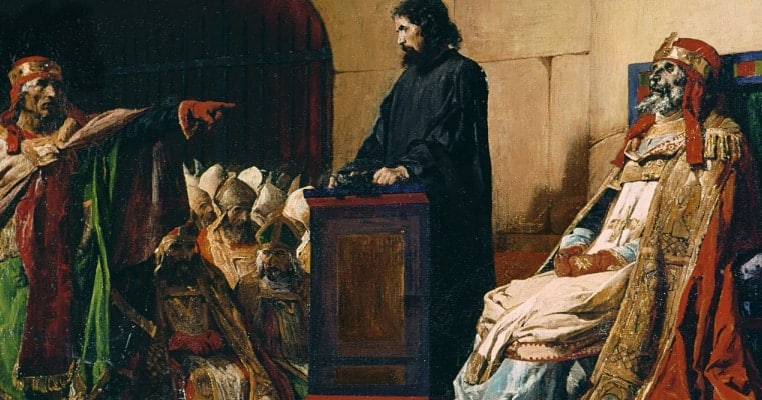Generally speaking, the papacy is a prestigious institution today, and popes are highly respected figures. During long stretches of the Dark Ages, however, popes were more like Rodney Dangerfield, in that they got no respect. Italy and Rome, particularly during the ninth and tenth centuries, were marked by feudal violence and anarchy, as the entire peninsula was torn apart by fiercely competing noble families. For the rival factions, the papacy was just another piece and prize in their Medieval Italian version of Game of Thrones. So they fought bitterly to seize the Holy See in order to put its spiritual, economic, and military resources to use in their quarrels.
Plenty of popes, then and later, knew how to hold a grudge, and there is no dearth of pontiffs who plotted and schemed against their predecessors, or even went so far as to outright murder them. Nor does history have a shortage of popes who were quite vindictive towards the very memory of their predecessors. However, no pope in the nearly two millennia long history of the pontificate ever came close to the levels of vindictiveness exhibited by pope Stephen VI. This Stephen was the only pope who was so vindictive that he had a predecessor’s corpse exhumed and put on trial, so he could finally tell him to his (dead) face just what he thought of him.

The Medieval Papacy Was a Bit Like Game of Thrones
After the collapse of the Western Roman Empire in the fifth century, Italy was fought over by the Ostrogothic Kingdom which ruled the peninsula, and the Byzantine Empire, which sought to reunify the former Roman Empire. The interminable wars between those rivals, fought on Italian soil, wreaked widespread havoc and devastation. Fighting did not peter out until the seventh century, when the Byzantines, weakened by the Muslim conquests, were forced to focus on survival at home instead of military adventurism abroad.
By then, Italy had been reduced from what had once been the central region of an urbanized, thriving, and sophisticated civilization, to a depopulated ruin. The vast infrastructure built during centuries of Roman rule was wrecked, as aqueducts, roads, bridges, and ports, had been either deliberately destroyed or allowed to fall into decay for lack of maintenance. Hitherto thriving estates lay in ruins, and agricultural productivity shrank as the rural population were reduced to small time peasants. Trade networks within Italy and across the Mediterranean, that had once allowed the urbanized culture of the Roman world to thrive, collapsed.
The collapse of the trade networks led to a collapse of the economy, which led to a population collapse in turn. Cities emptied, as their dwellers were either massacred by marauding armies, or had to feed themselves by becoming peasants and turning to subsistence farming in the surrounding countryside. Rome’s population had once reached as high as a million people, and the city still had a few hundred thousand people when the Western Empire fell. It was reduced to a small town of a few thousand souls, scavenging the decaying ruins for building materials. The Dark Ages had arrived in the Italian Peninsula, and it was against that background that the Cadaver Synod took place.

The Holy Father Stephen VI’s time on the papal throne was not that long, lasting for little more than a year between his election as pope in May of 896, until his death in August of 897. However, that was more than enough time to secure his place in the books, with one of the most controversial episodes in a papal history that has no shortage of controversy. It took place during a period, from roughly the middle of the ninth century to the middle of the tenth, that was marked by severe political instability in the Italian Peninsula.
In theory, the papacy spoke for and asserted authority over not only the Catholic Church, but over Christianity the world over. In reality, popes during this period were appointed and dethroned in rapid succession, based on the obscure machinations and intrigues of provincial Italian and Roman aristocratic families. Those rustics did not view the papacy and popes through our current global prism. Instead, to the factions in Rome and the surrounding region, the Holy See was simply another tool to be used in furthering their parochial ambitions, and in thwarting the ambitions of their rivals. Historical sources are relatively scarce as to the details of just what those rivalries revolved around, but the gist of them covered the basics: wealth, power, and prestige.

